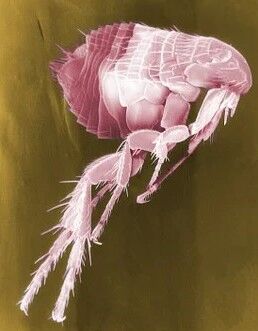If you can see one flea crawling around on your furniture, there are probably more where that came from. In such cases, quick action is the need of the hour. Many pet owners routinely face this issue if they’re not careful, but this doesn’t mean that you have to live with these pests for the rest of your life.
Just like you have to keep your guard up for garden pests, it’s necessary to stay vigilant if you have pets in the house. This requires treating both your home and your pet along with using the right products to get rid of the fleas. Here are a few steps to get you started:
Breaking the Cycle
The common flea goes through several stages in its life cycle. This includes the egg, the larvae, and finally the adult stage. The adult flea is the real pest, as it can bite and draw blood. They’re able to move from one host to another and are generally capable of making your life uncomfortable.
To eliminate fleas, however, one needs to break the life cycle completely. This means we have to work on the eggs and the larvae as well as the adults. If you have pests, they’re probably the ones who brought the fleas into your home. Start there first and schedule a visit to the vet. With the recommended treatment, you can start dealing with the problem at its source.
Check for Fleas
If you suspect that an area of your home has become infested with fleas, you can comb through each item of furniture looking for the culprits. Another way is to put on a pair of long, thick, white socks and walk around in the suspected area. This way, any adult fleas will jump on the socks. Repeat the experiment after you’ve treated your home and pets for fleas in order to make sure there are none left behind. These tips on DIY pest control might also be useful.
Clean Your Space
If you treat your pet but not your home, the pet is likely to get a flea infestation again. After you use that anti-flea shampoo or any other course of treatment recommended by your vet, get ready to thoroughly clean your home.
Flea larvae can easily live off whatever they find in your furniture, so tackle this area next. The first step is to vacuum the upholstery and wash any removable covers. If the infestation is still mild, you can control it this way. Just to be sure, concentrate your cleaning more in places where your pet spends a lot of time.
Here is a short checklist of the items that need immediate cleaning in case of a flea infestation:
- Pet bedding, including any cushions, pillows, or blankets they might use
- Pet toys
- Linens
- Rugs (throw them in hot water)
- Anything removable that your pet has been around
How to Vacuum
The vacuuming is one of the most important initial steps of getting rid of fleas. You need to do a thorough job, or the pests won’t be wiped out. A vacuum with a beater bar will probably do a better job than a regular one. Beater bars help to move the pile, getting to the larvae and eggs that might be hidden deep inside the rug or carpet.
Make sure to move all the furniture and vacuum behind and underneath it. Get some help in this if you have a bad back or can’t move the heavier items on your own. If there’s any large clutter around, pick it up manually so that the vacuum doesn’t choke. You may also want to put a flea collar inside your vacuum bag so that the fleas can be killed off as soon as they’re sucked inside.
In addition to the upholstery, make sure to vacuum the cushion–especially their seams and the spaces underneath them. The same goes for any crack or crevice you may find in your home. There are crevice tools available that can reach under kitchen cabinets and baseboard molding to remove any fleas.
When you’re done with vacuuming, seal the bag properly and dispose of it immediately. You may want to set it outside right away instead of in a dustbin inside your home.
Using a Flea Treatment
If your flea infestation is a little more serious, you may have to use some products to control it. These include chemical and natural options. The one you choose should have an insect growth regulator in order to give the best results.
Products such as methoprene and pyriproxyfen end the life cycle of fleas, doing away with these pests once and for all. You may also use foggers, but they require expert handling. Also, you would have to leave your home for some hours while it’s on and clean all the surfaces and utensils when you return.
Among the more natural options are certain essential oils, like lavender and eucalyptus. You can add a few drops of thee to some water and fill a spray bottle with the mixture. Routinely spray this on the furniture, including pet beds and any floor coverings.
Diatomaceous earth is another natural option; you’d have to spread this on the furniture and rugs. While it’s effective, it can be a pain to clean up.
Above all, make sure that your kids and pets stay away from any furniture that’s undergoing treatment. If you still find fleas after one round, clean and treat the furniture again.
Conclusion
The above methods are handy for getting rid of any existing fleas, but it’s also important to protect your home from pests in the first place. Regular cleaning can accomplish this goal to some extent, but infestations might happen despite all precautions. If the situation seems too far gone to control on your own, there’s no shame in calling in a professional specialist for your pest control needs.


